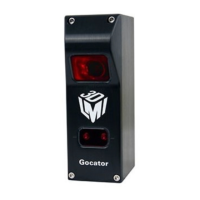Gocator Line Profile Sensors: User Manual
Gocator Web Interface • 324
3. Set Trigger Event to Software.
4. Specify a Signal type.
The signal type specifies whether the digital output is a continuous signal or a pulsed signal. If the
signal is continuous, its state is maintained until the next transition occurs. If the signal is pulsed, user
specifies the pulse width and the delay.
5. Specify a Pulse Width.
The pulse width determines the duration of the digital output pulse, in microseconds.
6. Specify if the output is immediate or scheduled.
A pulsed signal can become active immediately or be scheduled. A continuous signal always becomes
active immediately.
Immediate output becomes active as soon as a scheduled digital output (Schedule Digital Output on
page 471) is received.
Scheduled output becomes active at a specific target time or position, given by the Scheduled Digital
Output command. Commands that schedule an event in the past will be ignored. An encoder value is in
the future if the value will be reached by moving in the forward direction (the direction that encoder
calibration was performed in).
To output an exposure signal:
1. Go to the Output page.
2. Click Digital 1 or Digital 2 in the Output panel.
3. Set Trigger Event to Exposure Begin or Exposure End.
4. Set the Pulse Width option.
The pulse width determines the duration of the digital output pulse, in microseconds.
To output an alignment signal:
1. Go to the Output page.
2. Click Digital 1 or Digital 2 in the Output panel.
3. Set Trigger Event to Alignment.
The digital output state is High if the sensor is aligned, and Low if not aligned. Whether the sensor is
running does not affect the output.
To respond to exposure begin/end:
1. Go to the Output page.
2. Click Digital 1 or Digital 2 in the Output panel.
3. Set Trigger Event to Exposure Begin or Exposure End.
